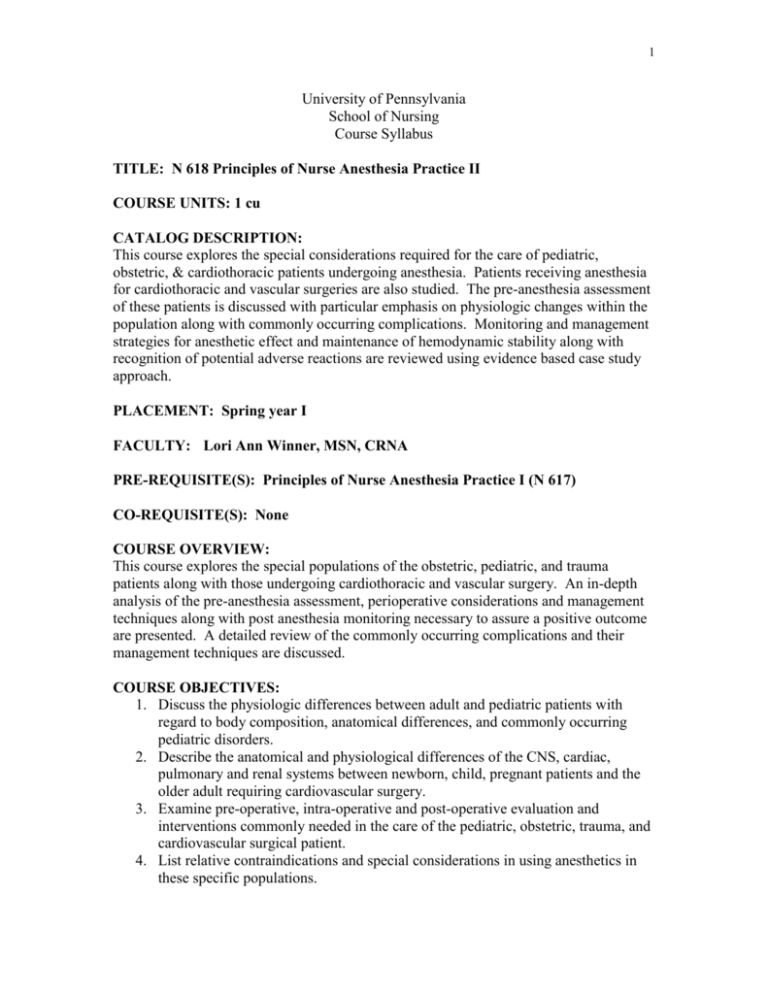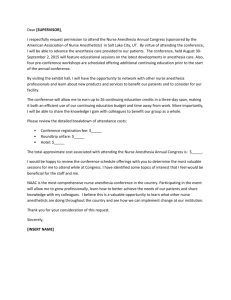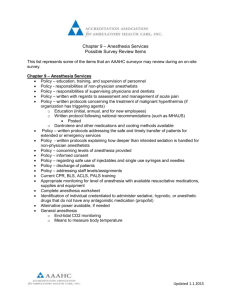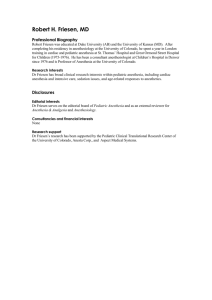N618 Principles of Nurse Anesthesia Practice II
advertisement

1 University of Pennsylvania School of Nursing Course Syllabus TITLE: N 618 Principles of Nurse Anesthesia Practice II COURSE UNITS: 1 cu CATALOG DESCRIPTION: This course explores the special considerations required for the care of pediatric, obstetric, & cardiothoracic patients undergoing anesthesia. Patients receiving anesthesia for cardiothoracic and vascular surgeries are also studied. The pre-anesthesia assessment of these patients is discussed with particular emphasis on physiologic changes within the population along with commonly occurring complications. Monitoring and management strategies for anesthetic effect and maintenance of hemodynamic stability along with recognition of potential adverse reactions are reviewed using evidence based case study approach. PLACEMENT: Spring year I FACULTY: Lori Ann Winner, MSN, CRNA PRE-REQUISITE(S): Principles of Nurse Anesthesia Practice I (N 617) CO-REQUISITE(S): None COURSE OVERVIEW: This course explores the special populations of the obstetric, pediatric, and trauma patients along with those undergoing cardiothoracic and vascular surgery. An in-depth analysis of the pre-anesthesia assessment, perioperative considerations and management techniques along with post anesthesia monitoring necessary to assure a positive outcome are presented. A detailed review of the commonly occurring complications and their management techniques are discussed. COURSE OBJECTIVES: 1. Discuss the physiologic differences between adult and pediatric patients with regard to body composition, anatomical differences, and commonly occurring pediatric disorders. 2. Describe the anatomical and physiological differences of the CNS, cardiac, pulmonary and renal systems between newborn, child, pregnant patients and the older adult requiring cardiovascular surgery. 3. Examine pre-operative, intra-operative and post-operative evaluation and interventions commonly needed in the care of the pediatric, obstetric, trauma, and cardiovascular surgical patient. 4. List relative contraindications and special considerations in using anesthetics in these specific populations. 2 5. List the commonly utilized techniques to provide anesthesia for pediatric patients. 6. Understand the anatomy of the placenta and placental transfer of drugs at term. 7. Discuss the factors influencing placental transfer of medication commonly used in providing obstetrical anesthesia. 8. Explain the pharmacological and non-pharmacological methods utilized for pain relief during labor. 9. Discuss the effect of anesthetics to fetus, and appropriate monitoring interventions employed in the care of an obstetrical patient having non-fetal surgery. 10. Discuss delivery of anesthesia to patients undergoing cardiothoracic and vascular surgery with specific focus on invasive monitoring and cardio pulmonary bypass. 11. Examine interventions to maintain hemodynamics stability during vascular procedures requiring cross clamping of major vessels during vascular surgery TEACHING METHODS: Lecture, discussion, case study presentation, simulation EVALUATION METHODS: Nurse Anesthesia Week Exam #1 (Pediatric) Exam #2 (OB) Exam #3 (CVCT) 10% 30% 30% 30% 1-26-2013 2-18-2013 3-18-2013 4-22-2013 GRADING POLICY A+ 97-100 A 93-96 A- 90-92 B+ 87-89 B 83-86 B- 80-82 C+ 77-79 C 73-76 C- 70-72 F 0-69 Grades will be rounded as follows: .1-.5 will be rounded up to .5; .6-.9 will be rounded to next whole number. Should a student be found responsible for cheating in this course, their grade for the course will be a failure. The University Code of Academic integrity will be followed in this course. It is available on Blackboard and the student handbook. 3 Code of Academic Integrity Since the University is an academic community, its fundamental purpose is the pursuit of knowledge. Essential to the success of this educational mission is a commitment to the principles of academic integrity. Every member of the University community is responsible for upholding the highest standards of honesty at all times. Students, as members of the community, are also responsible for adhering to the principles and spirit of the following Code of Academic Integrity. Academic Dishonesty Definitions Activities that have the effect or intention of interfering with education, pursuit of knowledge, or fair evaluation of a student’s performance are prohibited. Examples of such activities include but are not limited to the following definitions: A. Cheating: using or attempting to use unauthorized assistance, material, or study aids in examinations or other academic work or preventing, or attempting to prevent, another from using authorized assistance, material, or study aids. Example: using a cheat sheet in a quiz or exam, altering a graded exam and resubmitting it for a better grade, etc. B. Plagiarism: using the ideas, data, or language of another without specific or proper acknowledgment. Example: copying another person’s paper, article, or computer work and submitting it for an assignment, cloning someone else’s ideas without attribution, failing to use quotation marks where appropriate, etc. C. Fabrication: submitting contrived or altered information in any academic exercise. Example: making up data for an experiment, fudging data, citing nonexistent articles, contriving sources, etc. D. Multiple submissions: submitting, without prior permission, any work submitted to fulfill another academic requirement. E. Misrepresentation of academic records: misrepresenting or tampering with or attempting to tamper with any portion of a student’s transcripts or academic record, either before or after coming to the University of Pennsylvania. Example: forging a change of grade slip, tampering with computer records, falsifying academic information on one’s resume, etc. F. Facilitating academic dishonesty: knowingly helping or attempting to help another violate any provision of the Code. Example: working together on a take-home exam, etc. G. Unfair advantage: attempting to gain unauthorized advantage over fellow students in an academic exercise. Example: gaining or providing unauthorized access to examination materials, obstructing or interfering with another student’s efforts in an academic exercise, lying about a need for an extension for an exam or paper, continuing to write even when time is up during an exam, destroying or keeping library materials for one’s own use., etc. * If a student is unsure whether his action(s) constitute a violation of the Code of Academic Integrity, then it is that student’s responsibility to consult with the instructor to clarify any ambiguities. (Source: Office of the Provost, 1996) http://www.vpul.upenn.edu/osl/pennbook.html 4 PRESENTATIONS GUIDELINES: Students will complete a presentation in a professional manner in recognition of National Nurse Anesthetist Week (January 20-26, 2013). They can be of any venue I.E. video, presentation, PPT, community project ideas. Your presentations may be selected for display or presenting in areas within the School of Nursing, primary clinical sites, and local schools in a “Career Day” manner during National Nurse Anesthetist Week. This project can be completed as a group project with 2 students per group. If a larger venue is proposed, than we can agree on more students for % effort. Topics should celebrate the profession of nurse anesthesia and may include: 1) The history of Nurse Anesthesia Practice 2) Nurse Anesthetists in the Military 3) Nurse Anesthetist Education and Certification 4) The history of anesthetics 5) Issues surrounding the practice of Nurse Anesthesia (the individual issue must be approved by the course director and be stated in a political nature) Poster Presentations: Dimensions of a poster presentation should be in a tri fold style. A laser printer should be used to produce text with large enough fonts to permit easy reading. References should be sited in the lower right hand section of the poster. The group names and status as University of Pennsylvania Students should be identified on the poster. NO EXTENSIONS TO THE DUE DATE WILL BE GRANTED. Failure to complete this assignment by 1-26-2013 will result in no credit being assigned for this portion of the course grade to either student. Grading Criteria Organization of material (outline required) Image Content & quality Written word/text Overall concept presentation Overall delivery method 20% 20% 20% 20% 20% 5 REQUIRED TEXTS: Guyton, A.C. & Hall, J.E. (2006). Textbook of Medical Physiology 11th Ed. Philadelphia, PA: Elsevier Saunders. Rhoades, R.A. & Bell, D.R. (2009). Medical Physiology: Principles for Clinical Medicine 3rd Edition. Philadelphia: Lippincott, Williams, & Wilkins. Morgan, E.G., Mikhail, M. S., & Murray, M.J. (2006). Clinical Anesthesiology 4th Ed. New York: Lange Medical Division/McGraw-Hill Companies, Inc. Nagelhout, J. & Zaglaniczny (2007). Nurse Anesthesia 4th Edition. Missouri: Elsevier Saunders. Stoelting, R. & Hillier, S. (2006). Pharmacology and Physiology in Anesthetic Practice 4th Ed. Philadelphia: Lippincott Williams & Wilkins. RECOMMENDED TEXTS: Litman, R. (2004). Pediatric Anesthesia: The Requisites 1st Ed. New York: Mosby. Stoeling, R. & Miller, R. (2007). Basics of Anesthesia 5th Ed. New York: Churchill Livingstone. Barash, P.G., Cullen, B.F. & Stoeling, R.K. Eds. (2009). Clinical Anesthesia 6th Ed Phila., PA: Lippincott, Williams & Wilkins. Hurford, W. (2007). Clinical Anesthesia Procedures of the Massachusetts General Hospital 7th Ed. Phila., PA: Lippincott, Williams, & Wilkens. 6 Class Held Mondays 9am – 12pm Day/Time Week 1 Jan 9, 2013 (Wednesday) 1 – 4P (in N792) Matt McCoy January 14, 2013 9-4p Week 2 January 21, 2013 Topic Pediatric Anesthesia Assessment and interventions of physiologic presentations Objective 1-5, 16 Readings Nagelhout Chp 49 M&M Chp 44 N683 Content all day. Nurse Anesthetist Week NO CLASS! MLK DAY!!! Completed Projects Due 1-202012 Week 3 January 28, 2013 Pediatric Anesthesia Fetal Circulation 1-5, 16 Nagelhout Chp 49 M&M Chp 44 Lori Ortman Week 4 February 4, 2013 Pediatric Anesthesia Intraoperative management 1-5, 16 Nagelhout Chp 49 M&M Chp 44 Pediatric Anesthesia Intraoperative management continued 1-5, 16 Nagelhout Chp 49 M&M Chp 44 Matt McCoy Matt McCoy Week 5 February 11, 2013 Matt McCoy Week 6 February 18, 2013 PEDIATRIC EXAM Exam #1 Week 7 February 25, 2013 Dr. Gaiser Management of the Obstetrical patient – Physiological changes associated with pregnancy, Laboring Epidural anesthesia for Cesarean Section, post-dural puncture headache Week 8 March 4, 2013 NO CLASS SPRING BREAK!!!!!! Material from weeks 1,3,4,&5 2-4, 16 M&M Chp 45 Stol Chp 26 Nagelhout Chp 47 Assigned articles 7 Week 9 March 11, 2013 OB Simulation Session 2-4, 16 Exam #2 OB 2-4, 16 Material from weeks 7&9 CV/CT Anesthesia Monitoring, OR events 2-4, 10,11,16 M&M Ch 6, 19, 20, 21 Nagelhout Ch 17, 24-26 CV/CT Anesthesia Coronary Artery Bypass Surgeries & Valvular repairs 2-4, 10,11,16 Nagelhout Ch 24-26 M&M Ch 19, 20, 21 Central Line insertion & CPB Simulation Sessions 2-4, 10,11,16 Nagelhout Ch 24-26 M&M Ch 19, 20, 21 2-4, 10,11,16 M&M Ch 19, 20, 21 ** 8 – 12p Week 10 March 18, 2013 OB Case Scenarios Week 11 March 25, 2013 Lori Ann Winner Pete Conicelli Week 12 April 1, 2013 Lori Ann Winner Pete Conicelli Week 13 April 8, 2013 Lori Ann Winner Pete Conicelli ** 8 – 12p Week 14 April 15, 2013 Lori Ann Winner Week 15 April 22, 2013 CV/CT Anesthesia Cardio bypass Perfusion Device Aortic and Vascular Surgeries Continued Exam #3 CV/CT EXAM April 24- 26, 2013 Reading Days April 29-May 7, Final Exams 2013 TOTAL NUMBER OF THEORY HOURS: 45 TOTAL NUMBER OF CLINICAL HOURS: 0 Materials from weeks 11-14






